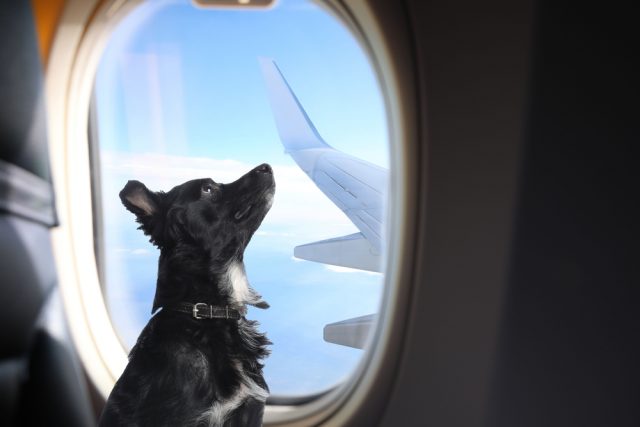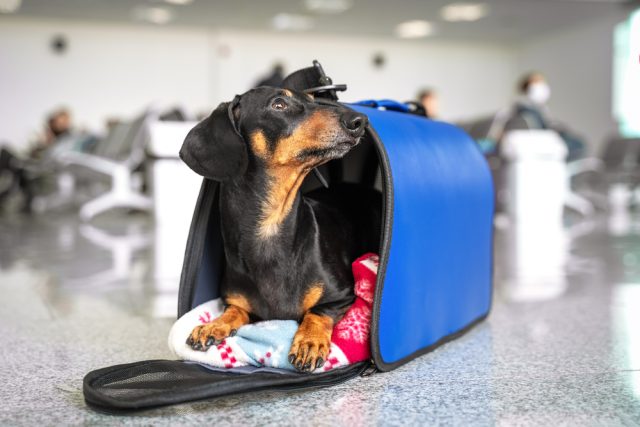With heartbreaking stories of pets dying during airline travel filling the headlines, you may wonder if this mode of transport is safe for your furry friends.
Kitty Block, CEO of the Humane Society of the United States, says flying with dogs and cats should always be a last resort.
If airline travel is unavoidable, knowing your rights, options, and the risks your pets may face will help empower you to advocate for their safety.

According to the Department of Transportation, United Airlines has reported the most animal deaths of all U.S. airlines for the past three years. Despite their PetSafe Program, United had 18 companion animal deaths in 2017 while all other airlines reported deaths in the single digits.
“The statistics are not good of how many die each year, and so that should not happen,” Block told CNN. “There are always going to be some accidents, but this many is a problem, so we’re really looking at this as it’s time to clean this up and it’s not an afterthought.”
The goal is to keep improving airlines’ animal care policies, but until then, Block advises being as prepared as possible on behalf of your pet.
“These are not cargo, they’re not suitcases, they’re living beings and they’re our family members. So we really have to make sure that it’s safe for our animals.”
Choosing The Right Airline
The first step in preparing to travel by air with your pet is to choose your airline. Policies vary widely by company, so do your research before purchasing your tickets. The website, Petfriendlytravel.com provides an extensive list of global airlines and their pet policies. You should also follow up by phone with your favored airline to ensure nothing has changed pre-flight.
Every airline requires some type of veterinary health check and certification in the days and weeks leading up to your flight. This is to ensure your pet is healthy enough to fly and not a risk to other passengers.
Some companies only care about the Rabies vaccination, while others may want full vaccination records. The time frame in which the veterinary exam and vaccines must be done varies by airline, so be sure to investigate these details carefully!
International Travel
If you will be traveling internationally, there is even more red tape, including the potential for quarantine. Pettravel.com offers a full list of country-specific pet immigration rules including the option to purchase necessary forms online.
When examining an airline’s pet policies, be sure to read the fine print! Some companies allow pets to travel, but do not allow them to ride in the cabin of the aircraft. According to CNN, Air France bans pups they consider “attack dogs” such as those resembling Staffordshire Terriers or Pit Bulls from flying with them – even in the cargo hold.
Size Matters
Most North American airlines allow pets up to about 20 pounds to be stowed under the seat in front of you in a TSA approved carrier. Since most cats meet the size and weight limit, this is by far the preferred method of air travel for them despite the higher fees.
Larger dogs, on the other hand, may have no choice but to fly in the airplane’s cargo hold. This area is often poorly ventilated and is not temperature-controlled, putting them at a higher risk for medical emergencies. It is also much louder under the plane and carriers are more likely to shift, adding to the stress.
Due to the harsh, potentially dangerous conditions in the cargo hold, the Humane Society of the United States strongly advises against allowing your pets to travel this way.
In fact, as a result of past incidents, some airlines no longer allow cargo travel for pets. In 2016, Delta Airlines announced it would no longer allow customers to check their pets with their baggage, unless they are active military with transfer orders or require a service animal.
And just this week, United Airlines also suspended the option of flying pets as cargo while they review their entire pet policy. They expect to announce a final decision by May 1, 2018.
Preparing Your Pup For Airline Travel
There are ways to help minimize the stress of airline travel on your pets including training, desensitization to loud noises, and even prescription medications.
In a 2012 interview with CNN, Cesar Milan discussed getting pets used to their carrier in preparation for the flight.
“Don’t just put them in a crate the day before. It should be a transition,” he said. “You have to teach your dog to hold its bladder — it’s almost like training for a marathon. Go through the process before you fly. For example, flying from Los Angeles to Spain is 14 hours.”

Discuss these issues with your veterinarian at your pet’s pre-flight wellness checkup. He or she may be able to recommend products, techniques or drugs to make travel easier.
Finally, The Humane Society recommends pet parents be persistently vocal about their animals’ needs – whether they are traveling in the cabin or in the cargo hold.
“It never hurts to let as many people know [that your animal is on board]. There can always be break down of communication,” Block says. “We can’t stress enough that when you have an animal in commercial travel, you really have to keep making sure that everyone’s aware of it and that it’s proceeding correctly.”

